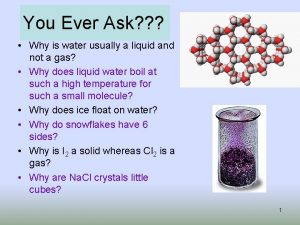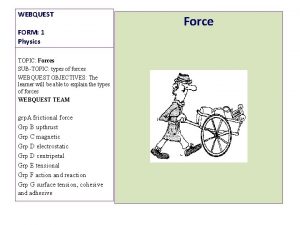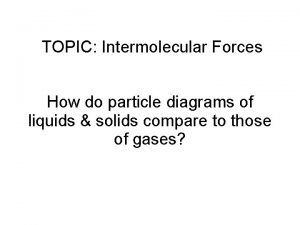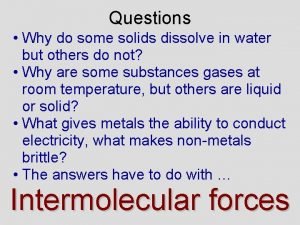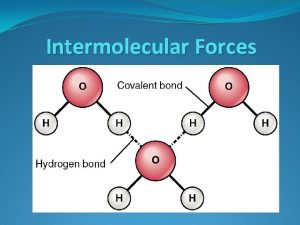Intermolecular Forces IMF Section 6 5 p 203









- Slides: 9

Intermolecular Forces (IMF) Section 6. 5 p. 203 11/20/14

IMF General Info • The impact that intermolecular forces have on molecules can be seen on how boiling points are impacted. – Reference Table 7 p. 204 • Generally, these forces are weaker than actual chemical bonds, but are still important in examining the properties of molecules.

Dipoles and Polarity • The strongest IMF exists between polar molecules. • Dipole = equal but opposite charges separated by a short distance. – Is represented by an arrow with its head pointing to the negative pole. – Ex: H - Cl

Dipole and Polarity • Polarity of diatomic molecules is determined by 1 Bond. • Polarity for molecules with more than 1 Bond is determined by orientation of each bond (aka molecular geometry / shape). – Figure 26 p. 205 • Ex: CO 2 -> bond polarities between each C = O cancel each other out bc the extend equally and symmetrically in opposite directions.

London Dispersion Forces • Even Noble gas molecules that are nonpolar experience weak IMF attraction. • This is because electrons are in constant motion and may cause the electron distribution to be uneven within an atom / molecule. • When this happens instantaneous dipoles are formed = “London dispersion forces. ”

London Dispersion Forces (LDFs) • These forces increase with the number of electrons present. • So there is a trend: – LDFs increase with increasing atomic # – Ex: Low boiling point of Noble Gases.

Practice Problems IMF • Complete p. 210 -211 #33 -42, 43, 45, 46, 50

Resonance Structures • Some molecules cannot be represented adequately by a single Lewis Structure. • Ex: Ozone – O 3 • In this example the two structure of ozone are constantly alternating and therefore is no average structure but 2 plausible version. • We use a double headed arrow in between the Lewis Structures to represent this.

 Intermolecular vs intramolecular forces
Intermolecular vs intramolecular forces Similarities of intermolecular and intramolecular forces
Similarities of intermolecular and intramolecular forces Intramolecular forces vs intermolecular forces
Intramolecular forces vs intermolecular forces Ch2cl intermolecular forces
Ch2cl intermolecular forces Webquest types of forces answers
Webquest types of forces answers Intermolecular forces
Intermolecular forces 3 types of intermolecular forces
3 types of intermolecular forces Concept of imfa
Concept of imfa How do intermolecular forces affect solvation
How do intermolecular forces affect solvation Intermolecular forces present in hbr
Intermolecular forces present in hbr



